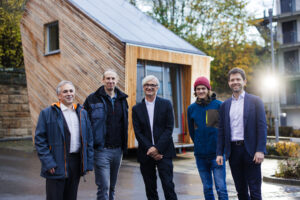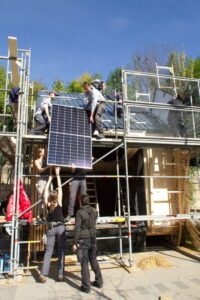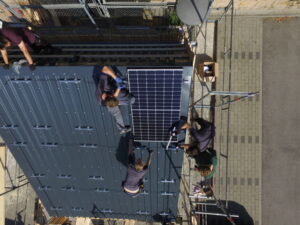
In our article Tiny House – The big trend for a small footprint we already told you about our participation in the Tiny House of the Coburg University of Applied Sciences. Today, we asked two colleagues who were responsible for the project planning and coordination with the university a few questions about the background and the exact process.
Dr. Stratis Tapanlis, Director C&I Energy Storage at IBC SOLAR, was immediately enthusiastic about the unusual project.
How did the collaboration with the university come about?
The Coburg University of Applied Sciences approached us directly in the summer of 2021 and presented the project idea to us. At the same time, they also asked whether we could support them in setting up the photovoltaic system and connecting the electricity storage system. We found the project very exciting and ultimately helped not only with the construction, but also with the products.
What attracted us to the project?

We found the opportunity to participate in a project with students and to jointly plan and install a quite sophisticated island photovoltaic system very exciting. It is important to us to pass on our know-how in the field to future generations of architects. In addition, the idea of designing the house according to cradle-to-cradle principles as well as relying on renewable raw materials convinced us to participate in the energy concept for the sustainable Tiny House.
Oliver Oswald, Project Engineer Central Technical Sales Support at IBC SOLAR, supervised the implementation of the project on site in Coburg. We wanted to know how the collaboration with the university went.
What challenges did the project management have for IBC SOLAR?
For us, working with Coburg University was a new experience. Normally, IBC SOLAR works with installers and craftsmen who have years of experience with PV systems. For the students from the fields of design and architecture, of course, this was all new territory. So in this case, we also took on the tasks of an installer and created the entire infrastructure on site. This also included providing the tools and consumables at the construction site.
The Tiny House was created as part of a project by architecture students from the Faculty of Design. How did design and technology come together?

For the university, it was important that the PV system and the associated technology fit into the design of the Tiny House. The components of the energy storage solution should not be visible and, of course, should not take up much space. Together with Prof. Hirth, we decided to “hide” the BYD Battery-Box Premium LVS energy storage system in the corner behind a cloudy glass wall. In this way, we found a good solution to ideally combine design, space efficiency and technology. Also, during the design process, it became clear that the Tiny House would generate more energy than it consumed during the summer months. For this reason, a charging station for e-bikes was installed in front of the house so that the available electricity can be used wisely.
How did the installation of the PV system and the storage solution work in practice?
We had two planning days in advance, one at our company headquarters in Bad Staffelstein and one at the Tiny House directly in Coburg. Within one day, we were able to install the PV modules and inverters. After that, other work had to be done on the house before the low-voltage installation and battery commissioning could take place a few weeks later. The students were very interested and there was a lively exchange. I enjoyed working with the motivated students, also because we had our student trainee Emil Stasch on site as a “mediator”.

I would also like to take this opportunity to thank my colleagues René Schüler, Stefan Böhmer and Theo Reklin, who actively supported me on site with the assembly, as well as my colleague Julia Wittmann, who took on the job coordination with the university, and Susanne Schnetter for the marketing coordination. It was very exciting for us to be in charge of an island plant like this, because it is still very rare in Germany.
We are very pleased that we were able to be involved in such an all-round successful project. And of course we hope that many future architects will plan roofs with PV suitability.